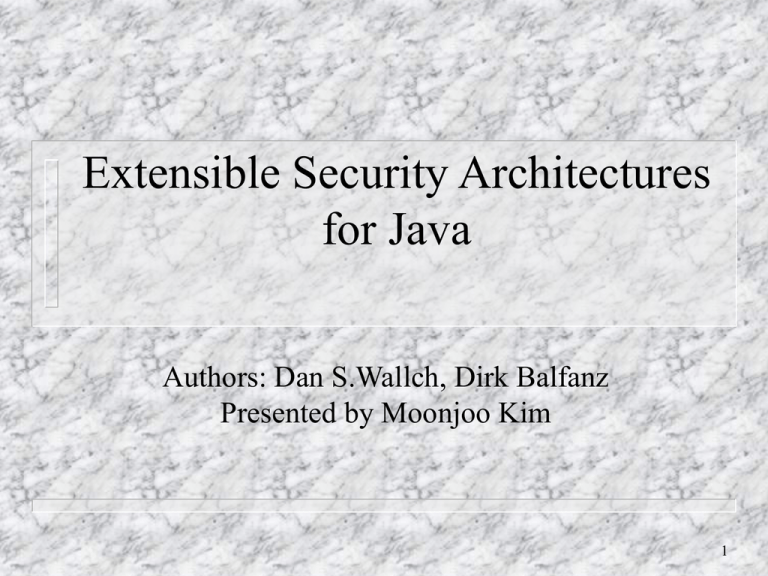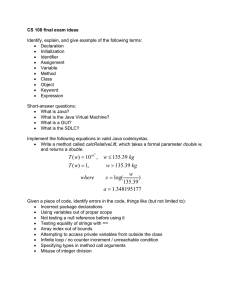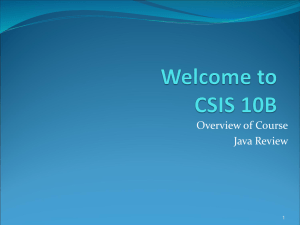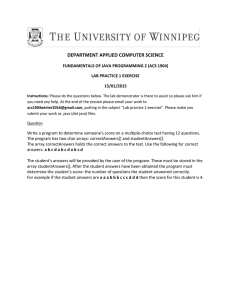Extensible Security Architectures for Java Authors: Dan S.Wallch, Dirk Balfanz
advertisement

Extensible Security Architectures
for Java
Authors: Dan S.Wallch, Dirk Balfanz
Presented by Moonjoo Kim
1
Outline of presentation
Introduction
Security in Java
3 Approaches
–
–
–
Evaluation of above 3 approaches
–
Capabilities
Extended Stack Introspection
Type Hiding-Analysis
Criteria
Conclusion
2
Introduction
Mobile code systems must have stronger
security
Web browsers rely on software mechanisms
for protection
Advantage of software protection over
hardware protection
–
–
Portability : Platform independent security
mechanism
Performance : Cheap cross-domain call
Secure services with software protection
–
Not only memory protection, but more!
Application
Kernel
Application
VM
Kernel
3
Security in Java
PL mechanisms to enforce memory safety
"Sandbox" model for sensitive system service in Sun's
JVM
–
–
Local code is completely trusted.
Remote code is completely untrusted.
Sun's JVM implementation to make above checks
–
ClassLoader
–
Stack introspection
Reference to the class in every frame on the call stack.
–
All the potentially dangerous methods were designed to call a
centralized SecurityManager
–
Too inflexible
4
3 Approaches
Providing fine-grain security policy
–
–
–
Distinguishing between "different" sources of programs
Provide appropriate policies for each of them.
All presume the presence of digital signatures
3 Approaches
–
–
–
Capabilities
Extended Stack Introspection
Type Hiding
5
Capabilities
A capability is an unforgeable pointer to a controlled
system resource.
In Java, a capability is simply a reference to an object
Java capabilities would implement interposition by
providing the exclusive interface to system resources
– Rather than using the File class, a program would be
required to use a file system capability acquired on
startup or through a broker
Java run-time library would require significant changes
6
// In this example, any code wishing to open a file must first
// obtain an object which implements FileSystem
interface FileSystem{public FileInputStream getInputStream(String
path);}
// This is the primitive class for accessing the filesystem.
// Note that the constructor is not public -- this restricts creation
of these
// objects to other code in the same package
public class FS implements FilsSystem{
FS(){}
public FileInputStream getInputStream(String path){
return internalOpen(path);
}
private native FileInputStream internalOpen(path);
}
// This class allows anyone holding a FileSystem to export a subset of
// that filesystem. Calls to getInputStream() are prepended with the
// desired filesystem root, then passed on to the internal FileSystem
capability
public class SubFS implements FileSystem{
private FileSystem fs;
private String rootPath;
public SubFS(String rootPath, FileSystem fs){
this.rootpath = rootPath;
this.fs = fs;}
public FileInputStream getInputStream(String path){
Extended Stack Introspection
To support multiple principals with different privileges
Target is defined as (prin,string-name)
– Ex> (System,"networking")
Policy engines
– given a principal requesting access for a target, say yes,no, or blank
enablePrivilege(target)
when code wishes to use the protected resource, call it. It will consult
policy engine and privilege is written in caller's stack frame if
permitted.
checkPrivilege(target)
It searches the call stack for an enabled privilege to the given target.
JVM should be modified for extended stack introspection
–
–
8
Example: Network Policy
•Default Java policy is to allow network connections to
be created only to the host from which the applet originated
•Implementation of default java network policy
Principal
Call Stack
user
User()
System
Safe_net_conn()
System
net_connect()
System
checkPrivilege()
Privilege operations
+networking
9
Type Hiding
Java uses run-time dynamic linking mechanism.
– We enforce a given security policy by controlling how
names in a program are resolved into run-time entities.
Policy engine determines which configuration is used for
the code's name space, as a function of its principal.
– Configuration, which is a mapping from class names to
implementations
Java ClassLoader should be modified
ClassLoader is used to provide mapping from classname to class-implementation
10
Example
Configuration
Original name
Java.net.Socket
Alice
Bob
Java.net.MySocket Java.net.Socket
Java.io.FileSystem
Java.io.SubFS
Policy engine
request
Bob
Class
Loader
Configuration
11
Criteria
Economy of mechanism
Complete mediation
Least privilege
Performance
Compatibility
Fail-safe defaults
Least common mechanism
Accountability
Psychological acceptability
Remote calls
12
Economy of mechanism
Type hiding is the simplest
Unmodified capability is simple, too. But
fully capability-based Java requires
redesign of library.
Stack introspection requires complex
change
13
Complete mediation
Simple capability is problematic
Type hiding have good confinement
property
Stack introspection have excellent
confinement.
14
Least privilege
Type hiding is somewhat problematic
Stack introspection provides middle ground
Capabilities have very good properties.
15
Performance
Stack introspection has the highest runtime
costs
Type hiding and capability system don't
incur run-time overhead
16
Compatibility
Language based protection can be
implemented without diverging much from
original specification of the language.
Type hiding and extended stack
introspection provide good compatibility
Capability requires changes of Java class
API design
17
Fail-Safe Defaults
Least common mechanism
Accountability
Psychological acceptability
Remote calls
18
Conclusion
Software-based protection systems
Three designs for security are suggested
– Capability system
It can be implemented naturally in Java. But it requires
drastic change of API design
– Stack introspection
It introspection offers good compatibility. But its
complexity is troubling and its implementation is very
specific to JVM
– Type hiding
It offers good compatibility.
To combine these techniques could be a solution
19




